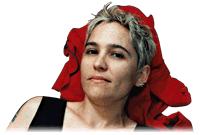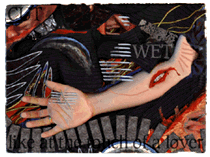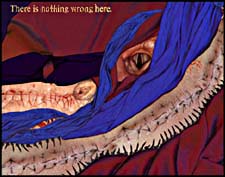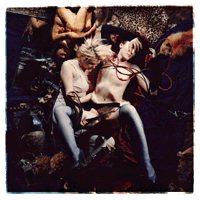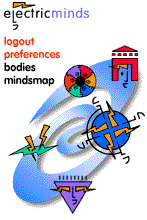
|

|
|
sydney - jonathon delacour
linda dement: making the unbearable visible I first met Linda Dement in 1986, in the course of assessing a Photography 1 class at Sydney's College of Fine Art. Around the walls of the room hung dozens of the usual carefully printed and tastefully mounted cliches (old men with silvery whiskers, close-ups of tree bark, self-portraits of the photographer reflected in a mirror, dappled light on stucco walls). And, hidden in a corner, some scrappy gray pictures of women with safety pins in their lips and nipples, junkies shooting up, and lesbian sex. Thank Christ, I thought to myself, someone photographing from her own experience. Her classmates were incredulous when I explained why Linda's pictures, despite their technical deficiencies, were infinitely superior to their own. It was like you saw the beginning of something in my work and made it clear to me that I could take it much further and that the little things that I was trying to do quite badly were actually something that could be worked on, that I could make them better. Linda enrolled in my class the following semester and in this, my defining moment as a photography teacher, I managed to do two smart things. Firstly, I suggested that since the content of her work was confronting to a mainstream audience, she should work hard to refine the form. If she could make the pictures exquisite to look at without diluting the subject matter, she could create strong feelings of tension and ambivalence in the viewer. Secondly, I shut up and got out of her way. I was trying to make my life different and going to art school became this really good therapy thing for me: it was obsessive, I just worked all the time. And it was particularly good, because for me the whole art thing, making pictures, was about making visible the way that I was feeling. So, instead of just sitting there and feeling something, I could make it real, turn it into objects and arrangements and pictures and somehow it felt like I was taking out each little bit and putting it into place. In that period, living in a house where people were constantly using, scoring, and dealing, she gave up heroin, to photograph with a vengeance. She made still life compositions of red and purple velvet, meat, women's and men's bodies, sex toys, mirrors, guns, knives, jewellery, flowers, and fur. They were gorgeous and disturbing, just as I had hoped. That they annoyed the hell out of the Marxist feminist brigade was the frosting on the cake. It was in the mid 80s, and a lot of the feminists really hated it. They would say, 'You know that's just the kind of demeaning stuff that men do to women, and all that kind of shit.' But, I was never really in the strong feminist circle anyway so it was no big deal to me. After graduating, she secured a job as a technician in the photography department, continued to make pictures, enrolled in the Masters program, and learned how to use a Macintosh. I had managed to get an image scanned and into the Mac Plus in the word processing lab, it was wonderful. On a tiny little screen, crappy one-bit graphics, and it was like magic. You could select little bits and copy them and paste them, wow. I was so excited. So then I just started to use computers all the time. At an Australian Network for Art and Technology workshop in Adelaide, she spent three weeks learning Macromedia Director. The transition from analog to digital was beginning, the bits were falling into place. There's something about ... the way that you arrange information in the computer, it's not just visual, you know, that's such a limited part... it's this whole that can be so much like the way things are in my head. That this bit of information can be connected to this bit of information and this other one and this other one and it could be words and it could be sound and it could be a picture or it might be moving. And so I wanted to work with that and make something with all that stuff. By 1992, Linda Dement had completed her first interactive work, Typhoid Mary, in which complex photomontages were combined with a cutup narrative about a depressed stripper.
Yet perhaps "interactive" is something of an oversimplification. I'm a total control freak. This bullshit about giving the user control, what a load of rubbish. In my work, I very deliberately set up where someone can go. If I think that there should be a connection, I put one there. They can't go other places, they go where I have put the pathways. Their only choice is to go there or not go there. Finally, she abandoned conventional photography, starting to place objects directly on the scanner. Body parts or objects, just things, if they're small put them on the scanner, then take them into ColorStudio. It was more like painting than photography. Because you spend much more time, just putting colour up in that little bit, or thinking about it more slowly. Like painting but you don't paint with colours, you paint with things. So I'd think: I need some more open heart surgery up in the right hand corner there. In 1994, during Artist's Week at the Adelaide Festival, she collected scanned body parts, sounds, and sentences from 30 women, making interactive conglomerate bodies in a CD-ROM work called Cyberflesh Girlmonster.
When a viewer activates a monster, you see or hear the words attached to that body part, another monster may appear, a digital video might play, a story or medical information may be displayed, all designed to produce a macabre comic representation of monstrous femininity. Currently, Linda Dement is Artist in Residence at the Australian Film, Television and Radio School in Sydney, using SoftImage on a Silicon Graphics workstation to create the content for her next CD-ROM. What I'm doing at the moment is the interior of a virtual wound. My work's always been about exactly the same thing. Making the unbearable visible. A wound I think is just a way into the body. So it's like, I'm thinking in that really literal way of wanting to go inside and bring stuff out and make some sense out of it. And I had to cut the skin open first in order to get in there. It's just over ten years to the day since I walked into that photography class. In the intervening period, Linda Dement has defined herself as one of Australia's leading interactive practitioners, remaining utterly true to the goal she first set herself: making the unbearable - her feelings - visible. Her work is dense and complex, beautiful to look at, difficult to come to terms with (particularly for men), uncompromisingly honest. She is a gifted artist and a loyal, generous, and constant friend. I love her dearly. |
mrjones said: Yes, John Howard cynically jumped on the popularist bandwagon of banning guns...we were seemingly happy to cheer as he ripped half a billion dollars off us to buy them back. Meanwhile the mental health system collapses for lack of funds, the sick are pushed back into a sometimes hostile society for lack of suitable care for them. Let the gun lobby keep their guns, they're a dying breed anyway, I'd rather spend the half a billion on developing a system of care that could avoid the next Martin Bryant. And no, John Howard did not jump on the Hanson bandwagon, no real votes there. His lack of leadership and statesmanship on the Hanson issue has shown him up as the shallow coward he is. Can you imagine JFK or Martin Luther King telling the country that they were "not going to buy into that one" He's a constitutional monarchist and what's more he's dead boring. Most Active Topics: Topic 34 Adelaide Topic 51 Racist Australia Topic 47 Ask Zentropy. | ||||||
| |||||||
Also in Sydney: a 21st century neighborhood linda dement: making the unbearable visible the museum of sydney: | |||||||
|
|

 That was actually shown at SIGGRAPH. Can you imagine like 50,000 American businessmen in suits looking at Typhoid Mary? It blows my mind.
That was actually shown at SIGGRAPH. Can you imagine like 50,000 American businessmen in suits looking at Typhoid Mary? It blows my mind.
